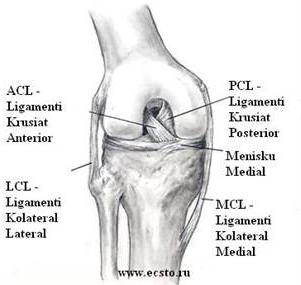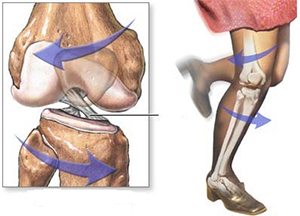Anterior Cruciate Ligament (Part One)
The Anterior Cruciate Ligament (ACL) is the knee ligament that is more frequently injured than other ligaments in this joint. In most cases, the ligament is damaged in individuals participating in sports activities. As sports have become an increasingly integral part of life in recent years, the number of ACL injuries has been on the rise. Surgeons in the last 15 years have given great importance to this injury, and successful operations for ACL reconstruction have been discovered for its repair.
This guide will help you understand:
- the location of the anterior cruciate ligament (ACL) in the knee
- how ACL injuries occur
- how doctors treat this condition
Anatomy
Where is the anterior cruciate ligament (ACL) located and what is its function?
Ligaments are strong bands of tissue that connect the ends of bones together. The ACL is positioned in the center of the knee, extending from the back of the femur (thigh bone) to connect with the front part of the tibia (shin bone).

The ACL passes through a special notch in the femur called the intercondylar notch and attaches to a specific area on the tibia called the tibial spine.
ACL is the primary element that controls how far the tibia moves forward under the femur. If the tibia goes too far, the ACL may tear. The ACL is the first ligament to tighten when the knee is fully extended. If the knee is forced to go beyond this point or hyperextend, the ACL may also tear.
Other parts of the knee may be damaged when the knee is subjected to force, such as in a direct impact in football. It is not uncommon to see a tear in the medial collateral ligament (MCL) on the inner side of the knee and the lateral meniscus, which is a U-shaped cushion between the outer part of the tibia and the femoral condyles.
Causes
How do ACL injuries occur?
The primary cause of ACL injuries is sports-related. There are many types of sports associated with ACL tears. Sports that involve planting the foot and rapid changes in body direction, such as basketball, have a high incidence of injury. Football is also a common source of ACL injury. Football combines leg movement with high speed and the threat of bodily contact. Skiing is another frequent source of injury, especially from landing in ski boots that reach up to the thigh. These boots alter the impact of falling on the knee more than on the feet or ankles. An ACL injury usually occurs when the knee is forcibly twisted or hyperextended. Many patients hear a popping sound when the ligament tears, and it feels as if the knee moves out of place.
The number of women suffering from ACL injuries has dramatically increased. This is partly due to the growing number of female athletes. However, studies have shown that female athletes are 2-4 times more likely to experience ACL tears than male athletes in the same sports.
Recent research has identified factors contributing to the higher risk of ACL tears in women. Female athletes seem to have a smaller ability to strengthen the muscles in the thigh to the same extent as men. This means that women may not stabilize their knees as effectively, providing less protection to the knees during intense physical activities. Also, tests show that the quadriceps of women and the posterior thigh muscles work differently than in men. The quadriceps muscles of women (in the front part of the thigh) work much harder during knee-related activities. This leads to the forward pull of the tibia, risking an ACL tear.

Meanwhile, the posterior thigh muscle group of women (M. biceps femoris, M. semitendinosus, and semimembranosus) (on the back side of the thigh) responds more slowly than in men. The muscles of the posterior group normally protect the tibia from sliding too far forward. The slow reaction of the muscles in the posterior group of women may allow the tibia to slide forward, leading to an ACL tear. Other studies show that women's ACL can be weakened by the effects of estrogen hormone. Taken together, these factors may explain why female athletes have a higher risk of ACL tears.
Symptoms
How does an ACL tear feel?
Symptoms after an ACL tear can vary. Usually, the knee swells within a short time after the injury. This is due to bleeding into the knee from the blood vessels torn in the damaged ligament. Instability caused by the torn ligament leads to a feeling of insecurity and giving way of the knee, especially when attempting to change its direction. The knee may feel like it wants to slide backward.
Pain and swelling from the initial injury usually subside after 2-4 weeks, but the knee may still feel unstable. Symptoms of instability and the inability to trust the knee for support are what require treatment. Also, it is important to note in the treatment decision that orthopedic surgeons have realized that long-term instability leads to early knee arthritis.
I received information, but in one line it mentions about the decrease in estrogen, what happens with the weakening of the ligament when we have a decrease due to menopause at the age of 40-50 years. Thank you
Sent by luljetalaci, më 19 Agust 2013 në 11:59
I have an ACL (anterior cruciate ligament) injury. If I undergo surgery, can I play football again?
Sent by erion cara, më 22 December 2013 në 13:10
I have damaged the ACL ligament twice, what needs to be done and if I do not undergo surgery, can I play soccer?
Sent by elsamir, më 28 September 2014 në 04:54